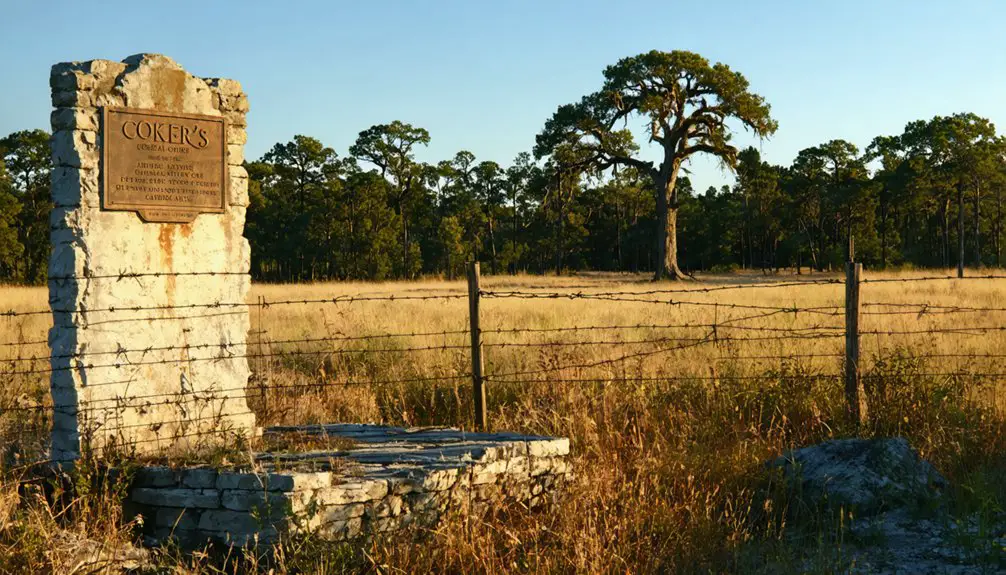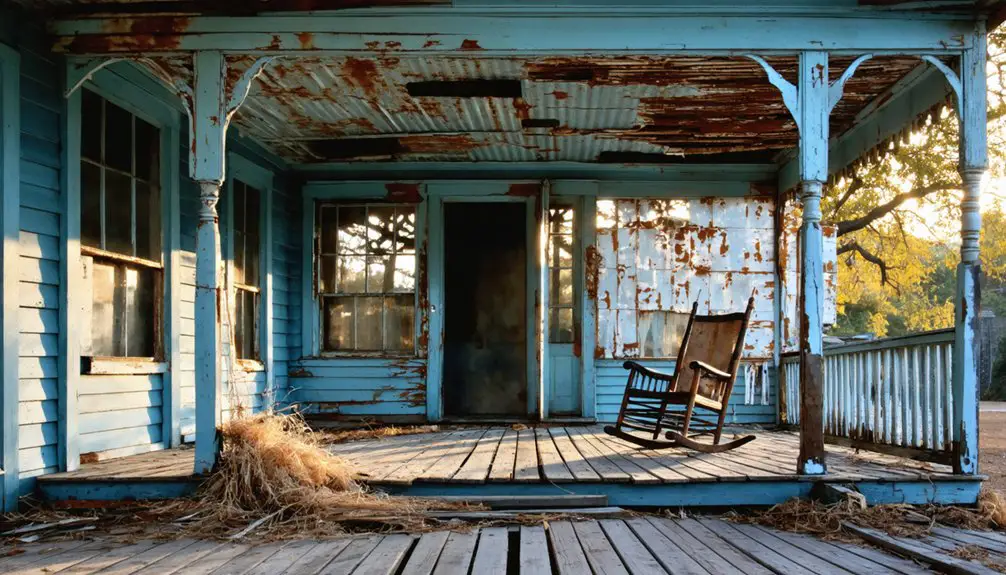You’ll find Coker, Texas nestled on San Antonio’s outskirts, where Texas Revolution hero John Coker established a frontier settlement in 1841 after receiving land for his service at the Battle of San Jacinto. The once-thriving agricultural community centered around Coker Methodist Church and a schoolhouse, with pioneer families like the Cokers and Browns forming its backbone. Today, only Coker Cemetery remains, holding both historical significance and paranormal tales that echo the settlement’s fascinating past.
Key Takeaways
- Coker was a vibrant frontier settlement during the Republic of Texas era, centered around a Methodist church and schoolhouse.
- The community was established by John Coker, a Texas Revolution veteran who received land grants for his service.
- Agricultural activities, including farming and cattle drives, formed the economic backbone of early Coker.
- The expansion of San Antonio and changing transportation routes led to Coker’s decline and eventual ghost town status.
- Coker Cemetery remains as the primary historical landmark, preserving the community’s legacy through graves and historical markers.
From Battlefield Glory to Settlement: The John Coker Story
After distinguishing himself at the Battle of San Jacinto in 1836, John “Jack” Coker transformed from a Texas Revolution soldier into a pioneering settler of north central Bexar County.
His battlefield valor earned him substantial rewards in the newly formed Republic of Texas, including a “third of a league” and a “first-class headright” of 1,920 acres.
You’ll find that Coker didn’t waste time putting his land grants to good use. By 1841, he’d established a permanent homestead built from cut limestone and founded the Coker community with help from his brothers Joseph and James. His heroic role in destroying Vinces Bridge during the war proved crucial to Texas independence.
His strategic decision to settle this frontier region aligned perfectly with the Republic’s goals of securing and populating the territory through veteran land awards.
His legacy lives on through the Coker Cemetery, which he helped establish and where he was laid to rest in 1861.
Life in Early Coker: A Republic of Texas Community
Once the Coker homestead took root, a vibrant frontier community quickly emerged around it during the Republic of Texas era. You’d have found the Methodist church and schoolhouse serving as essential gathering points, where pioneer resilience shone through daily life.
The community dynamics centered around large pioneer families like the Cokers, who connected through marriages with other settlers like the Browns.
Early settlers forged lasting bonds through intermarriage, weaving together families like the Cokers and Browns into a tight-knit frontier community.
You would’ve witnessed a bustling settlement where farming and cattle drives shaped the economic landscape. Despite the challenges of frontier warfare and the tragic loss of young Loucious Monroe Coker, the community’s spirit remained unbroken. The settlers faced numerous hardships including rattlesnakes and droughts while carving out their existence. The area flourished after John Coker received nearly 2,000 acres for his service in the Battle of San Jacinto.
Social bonds strengthened through shared experiences at church services, school lessons, and community events, while the fertile land along Salado Creek supported the settlers’ agricultural pursuits.
The Rise and Fall of a Central Texas Town
While John Coker’s initial 1,920-acre land grant laid the cornerstone for this Central Texas settlement in 1841, you’d have seen Coker transform from a simple homestead into a thriving agricultural community.
Coker’s economy centered on farming and ranching, with its men often serving as Texas Rangers to protect the frontier. Much like the miners of Thurber who used company store scrip, residents here relied heavily on local merchants for their basic needs. You’d have found a tight-knit society where community members like Sarah Jane Coker provided crucial healthcare through midwifery. Similar to Old Alton Bridge, only a few historical remnants survive from this once-bustling settlement.
The Methodist church and schoolhouse became essential gathering places, showcasing the settlement’s commitment to education and faith.
Despite its early resilience, Coker couldn’t withstand the winds of change. As San Antonio expanded and transportation routes shifted, the community gradually dissolved.
Today, only the historic cemetery remains, preserving the legacy of these pioneering Texas settlers.
Haunting Tales From Coker Cemetery
If you’re brave enough to visit Coker Cemetery after dark, you’ll encounter more than just weathered Texas Ranger headstones and crumbling family plots.
The chapel’s basement, with its body-stained concrete vaults and unexplained cold spots, has become notorious for paranormal activity including metallic screeching sounds and mysteriously opening crypt doors. During winter months, these vaults once held up to thirty stored caskets. Due to limited space, graves were often dug with bodies buried three deep underground.
Among the multi-layered graves and unmarked plots, the most chilling location remains the final resting place of Eliza Alberti, the “Demented Mother” whose 1894 crimes still echo through visitors’ encounters with shadow figures and inexplicable phenomena.
Supernatural Night Encounters
Deep within the weathered grounds of Coker Cemetery, paranormal activity intensifies as darkness descends, drawing both ghost hunters and curious visitors to its haunted paths.
You’ll encounter supernatural phenomena ranging from shadowy apparitions to unexplained voices captured on spirit boxes near specific gravesites. The most intense ghostly encounters often occur near the infamous “Demented Mother’s” grave, where a tragic 1894 murder-suicide took place. Many investigators use pinwheels for communication with the spirits who rest here.
As you venture through the overgrown terrain after sunset, you’ll notice dramatic temperature drops and electronic interference. The Coker Methodist Church once anchored this historic settlement before urban development transformed the landscape.
The cemetery’s dense foliage and historic graves of Texas Rangers create an atmospheric backdrop where partial apparitions manifest.
Whether you’re investigating the layered burial plots or documenting EVP responses, you’ll find yourself immersed in one of Texas’s most actively haunted locations.
Mysterious Unmarked Graves
Throughout the historic grounds of Coker Cemetery, numerous unmarked graves dot the landscape, carrying untold stories of early Texas settlers, children, and frontier families.
You’ll find these unmarked graves scattered among the more visible markers, their presence a reflection of the challenging frontier conditions of early Texas life. Many belong to pioneers who helped shape the region’s history, including veterans of the Texas Revolution and Civil War.
The historical significance of these unmarked resting places extends beyond mere burial sites – they represent the modest means of settlers, the high infant mortality rates of the era, and the social dynamics of 19th-century Texas.
While overgrowth and time have obscured many grave locations, local records and family histories help preserve the memory of those interred beneath these silent stones.
Preserving the Legacy: Historical Sites and Markers

While Coker’s status as a ghost town signifies its physical decline, the community’s legacy endures through several carefully preserved historical markers and sites.
You’ll find three official Texas Historical Markers within Coker Cemetery, each telling a unique story of pioneer spirit and determination. The cemetery’s historical preservation efforts, led by the Coker Cemetery Association since 1967, guarantee these stories won’t be forgotten.
- John “Jack” Coker’s marker commemorates his heroic role in Texas independence
- The cemetery grounds, donated by Joseph Coker, received Historic Texas Cemetery status in 2009
- Community engagement continues through the nonprofit’s active maintenance and programming
- Limestone headstones, including Loucious Monroe Coker’s memorial, stand as silent sentinels
- Public accessibility near Coker United Methodist Church invites visitors to explore this heritage site
The Ghost Town’s Place in Modern Texas History
As an enduring representation to Texas’ evolving landscape, Coker’s metamorphosis from a thriving frontier settlement to a ghost town mirrors the broader narrative of the state’s modernization.
You’ll find that this once-vibrant community’s ghost town significance extends beyond its physical remains, serving as a compelling case study of how rural Texas settlements faced the unstoppable tide of progress.
The urbanization impact of San Antonio’s expansion effectively swallowed Coker whole, converting its farmlands into suburban developments and modern infrastructure.
Today, while you won’t find the bustling community that once existed, Coker’s story continues to resonate as a powerful reminder of Texas’ evolution from its frontier roots to its current metropolitan character, preserved through its cemetery and local historical accounts.
Frequently Asked Questions
What Was the Average Population of Coker During Its Peak Years?
You’ll find population growth during peak years was likely around 150 residents, though exact numbers aren’t documented. This estimate aligns with similar Texas ghost towns’ historical patterns.
Are There Any Remaining Original Structures From Coker Still Standing Today?
You’ll find some original buildings remain as ruins, though they’re fenced off with no trespassing signs. Historical preservation is limited, with only scattered remnants and old mining equipment still standing.
What Natural Disasters or Events Contributed to Coker’s Decline?
While flood damage wasn’t significant, you’ll find drought effects were devastating, as extended dry periods in the early 1900s destroyed crops and combined with the boll weevil’s assault on cotton production.
Did Any Famous Outlaws or Notorious Incidents Occur in Coker?
You won’t find any documented outlaw legends or notorious events tied to this place – historical records show it was primarily known for its founding family and peaceful rural community life.
What Crops or Livestock Were Primarily Raised in Early Coker?
You’ll find cattle dominated the livestock diversity, while cotton cultivation and corn were major crops. Farmers also raised hogs, poultry, and grew vegetables for their families’ sustenance.
References
- https://cokercemetery.com/haunting_the_graveyard.html
- https://en.wikipedia.org/wiki/List_of_ghost_towns_in_Texas
- https://en.wikipedia.org/wiki/Coker
- https://kids.kiddle.co/Coker
- https://www.tshaonline.org/handbook/entries/coker-tx
- http://www.texasescapes.com/CentralTexasTownsNorth/BulcherTexas/BulcherTexas.htm
- https://www.tshaonline.org/handbook/entries/coker-john
- https://texashistory.unt.edu/ark:/67531/metapth665270/
- https://cokercemetery.com/jeanettejones.html
- https://www.findagrave.com/memorial/6925651/john-coker



